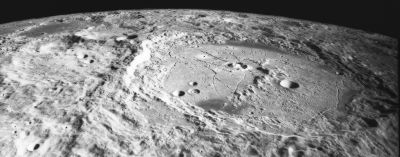Barnard
Contents
Barnard
|
Lat: 29.5°S, Long: 85.6°E, Diam: 105 km, Depth: 2.66 km, Rükl: 60 |

Apollo 15 AS15-M-2510 processed by Stefan Lammel. Barnard (left) & Humboldt (right)
Images
LPOD Photo Gallery Lunar Orbiter Images Apollo Images
Maps
(LAC zone 99C3) USGS Digital Atlas PDF
IAU page: Barnard
Description
Description: Wikipedia
Additional Information
- Depth data from Kurt Fisher database
Westfall, 2000: 2.66 km - Two (almost identical-twin looking) craters on the floor of Barnard are good "signposts" to find the location of Barnard itself while observing the moon's southeastern limb through the telescope. See LPOD March 10, 2014 (photograph Damian Peach).- DannyCaes Mar 10, 2014
Nomenclature
- Named for Edward Emerson Barnard (December 16, 1857 – February 6, 1923), an American astronomer. He was commonly known as E. E. Barnard, and was recognized as a gifted observational astronomer. In 1892 he made observations of a nova and was the first to notice the gaseous emissions, thus deducing that it was a stellar explosion. The same year he also discovered Amalthea, the fifth moon of Jupiter. He was the first to discover a new moon of Jupiter since Galileo Galilei in 1609. This was the last satellite discovered by visual observation (rather than by examining photographic plates or other recorded images). He is also known for his 1916 discovery of the very large proper motion of Barnard's Star, which is named in his honor. It is the second nearest star system to the Sun, second only to the Alpha Centauri system. Barnard received the Astronomical Society of the Pacific's 1917 Bruce Medal and extensive links to information about him can be found there.
- The selection of Barnard as a name for this previously unnamed limb feature was proposed by Arthur and Whitaker in the Rectified Lunar Atlas (1963) and approved in IAU Transactions XIIB (1964).
LPOD Articles
Cosmos and the Moon (Humboldt region, Damian Peach).
Bibliography
- Harold Hill. A Portfolio of Lunar Drawings, page 239 (limb regions south and east of Humboldt).
E. E. Barnard in the Sourcebook Project (William R. Corliss)
- In Mysterious Universe, a handbook of astronomical anomalies (1979)
List of articles in which E.E.Barnard is mentioned :
- Page 110: Illusions (E.M.Antoniadi, Journal of the British Astronomical Association, 1897).
- Page 116: The Radial Markings of Venus and their Modern Resurrection (James C. Bartlett, Strolling Astronomer, 1955).
- Page 118: The Radial Markings of Venus: Another Point of View (Patrick Moore, Strolling Astronomer, 1955).
- Page 120: A review of some ALPO Venus studies (Dale P. Cruikshank, Strolling Astronomer, 1963).
- Page 123: On the Observed Appearance of a Remarkable Light Spot on the Night Side of Venus (Richard M. Baum, Strolling Astronomer, 1956).
- Page 183: Why was Last December's Lunar Eclipse so Dark? (Edward M. Brooks, Sky and Telescope, 1964).
- Page 278: Remarkable Flight of Telescopic Meteors (W.R.Brooks, Observatory, 1884).
- Page 385: On some Objections to the Reality of Prof. Lowell's Canal System of Mars (E.M.Antoniadi, Journal of the British Astronomical Association, 1910).
- Page 445: W. H. Pickering and the Satellites of Jupiter (Joseph Ashbrook, Sky and Telescope, 1963).
- Page 455: Double Shadow of Jupiter's Satellite I (H.S.Hulbert, Astronomy and Astrophysics, 1892).
- Page 467: On the Observations of the Reported Dusky Ring outside the Bright Rings of the Planet Saturn (R.M.Baum, Journal of the British Astronomical Association, 1954).
- Page 476: The White Spot on Saturn's Rings (Hugh M. Johnson, Journal of the British Astronomical Association, 1941).
- Page 484: A Note on the Appearance of Saturn at Opposition (C.O.Bartrum, Journal of the British Astronomical Association, 1914).
- Page 486: White Spot on Saturn (W.F.Denning, Scientific American, 1903).
- Page 487: The White Spot on Saturn (Science, 1933).
- Page 506: Barnard's "Unexplained Observation" (Joseph Ashbrook, Sky and Telescope, 1956).
- Page 517: Observations of an Unidentified Object seen near the Sun on Sunday, August 7, 1921 (W.W.Campbell, Publications of the Astronomical Society of the Pacific, 1921).
List of articles of E.E.Barnard himself :
- Page 346: The Midnight Illumination above the Northern Horizon near the time of the Summer Solstice (Astrophysical Journal, 1906).
- Page 452: Observations of the planet Jupiter and his Satellites during 1890 (Royal Astronomical Society, Monthly Notices, 1891).
- Page 455: On the phenomenon of the Transit of the First Satellite of Jupiter (Royal Astronomical Society, Monthly Notices, 1892).
- In Lightning, Auroras, Nocturnal Lights, and related luminous phenomena (1982) :
- GLA13-R25 and GLA23-R11/R12: Self-Luminous Night Haze (Proceedings of the American Philosophical Society, 1911 and 1919).